When '500 men' (erima te rau) moved the border line, intruding
on the land of Hanau Momoko, it could have referred to
day 500 (= 365 + 135).
Right ascension day 55 (May 15) was not
included in the name givings of Makoi:
|
1 Ko Apina Iti |
27 |
29 Ko Te Rano A Raraku |
23 |
54 Vai Rapa |
(55) |
4 |
60 Apina Nui |
|
29 |
24 |
5 |
|
58 |
|
te ua |
koia ra |
kua tuku ki to
mata - ki tona tukuga |
e kiore - henua -
pa rei |
|
Ua.
  
1. Cause, reason why something
happens or is done; he ûa te ua, au i-ta'e-iri-ai
ki tooku hare, because of the rain, I did not go
home; ua kore, without cause, without reason.
2. Ceremononial stave with a human face carved at
one extremity. Vanaga. Cfr toko. 1. A long
club T. 2. Mgv.: ua, the genitalia. Ta.:
hua, id. Mq.: hua, id. Ha.: hua,
testicles. 3. Ta.: ua, the back of the neck.
Ma.: ua, id. Sa.: ua, the neck. 4.
Ta.: ua, a land crab which shears iron. Ma.:
uka, lobster. Sa.: uga, the hermit
crab. Churchill. Ûa.
Rain; 1. ûa hakamito, persistent,
but not strong, rain; 2. ûa kura, fine rain,
drizzle; 3. ûa matavaravara, strong rain; 4.
ûa parera, torrential rain; 5. ûa tai,
rain followed by fair weather at sea. Ehu ûa,
drizzle. Vanaga.
Ûaûa. Tendons, muscles. 1. Hau ûaûa
kio'e, line made from rats' tendons. 2. Ûaûa
toto, vein, artery. 3. Ûaûa piki, spasm.
Vanaga. 1. Rain; hoa mai te ua, to rain;
mou te ua, to cease raining. P Mgv., Mq., Ta.:
ua, rain. 2. Vein, artery, tendon (huahua
1) (uha
G); ua nene,
pulse; ua nohototo,
artery, ua gaei,
pulse. Uaua,
vein, tendon, line;
kiko uaua, muscle T.
Hakauaua,
to mark with lines. P Pau.:
tare-ua,
tendon. Mgv., Mq., Ta.:
uaua, vein, tendon. Churchill.
U'a. Of the
tide, to reach its maximum; tai u'a, high
tide. Vanaga. Wave, surge; tai ua, high tide.
Churchill. Uá. Ata
uá, morning twilight.
Uáuá, to
reside; resident; noho uáuá to settle
somewhere; ina koe ekó noho uáuá, do not
establish yourself there. Vanaga.
Ko. 1. Article (ko te);
preposition: with (see grammar); prefix of
personal pronouns: koau, I; kokoe, you
(singular); koîa, he, she, it; kokorua,
you (plural); ko tagi, koîa, he with his
weeping. 2. Article which precedes proper nouns,
often also used with place names: Ko Tori, Ko
Hotu Matu'a, Ko Pú. Koîa, exact:
tita'a koîa, exact demarcation. Seems to be the
personal pronoun koîa - applied in the
meaning of: thus it is, here it is precisely.
Vanaga. 1. Negative; e ko, not, except; e
ko ora, incurable; ina ko, not; ina ko
tikea, unseen; ina e ko, not; ina e ko
mou, incessant. 2. A particle used before nouns
and pronouns; ko vau, I; ko te, this;
ko mea tera, this; ati ko peka, to
avenge, ko mua, first, at first, formerly. 3.
There, yonder. P Mgv.: ko, over there,
yonder. Ta.: ó, there, here. Churchill.
Ta.:
ra, a day.
Pa.
1. Mgv.: pa, an inclosure, a
fenced place. Ta.: pa, inclosure,
fortification. Mq.: pa, inclosure. Sa.: pa,
a wall. Ma.: pa, a fort. 2. Mgv.: pa,
to touch. Sa.: pa'i, id. Ma.: pa, id.
3. Mgv.: pa, to prattle. Ta.: hakapapa,
to recount. 4. Mq.: pa, a hook in bonito
fishing. Sa.: pa, a pearlshell fishhook. Ma.:
pa, a fishhook. Pau.: hakapa, to feel,
to touch. Mgv.: akapa, to feel, to touch, to
handle cautiously.
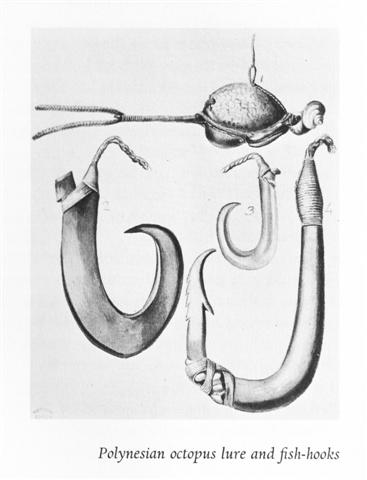
... Ana
Onoono is a cave well-suited as an overnight
shelter; Pu Ngotangota is a coastal formation where
the seawater is allowed to flow in and out. The
three additions, 'house', 'cave', and 'hole', always
describe an enclosed area ...
This statement of Barthel ought to
be extended to include also pa itself.
... In
later research it was postulated that the
[Phoenician] alphabet is actually two complete
lists, the first dealing with land agriculture and
activity, and the second dealing with water, sea and
fishing. The first half
beginning with Alef - an ox, and ending with
Lamed - a whip. The second list begins with
Mem - water, and continues with Nun -
fish, Samek - fish bones, Ayin - a
water spring, Peh - the mouth of a well,
Tsadi - to fish, Kof, Resh and
Shin are the hook hole, hook head and hook
teeth, known to exist from prehistoric times, and
the Tav is the mark used to count the fish
caught ... |
 |
 |
 |
 |
|
Cb2-4 (420 = 7 * 60) |
Cb2-5
(29) |
Cb2-6 |
Cb2-7 |
|
... The Maya word cab
means earth, world, tierra, the place below,

opposed to caan, the sky.
The overwhelming evidence on the glyph and its
associations in the pictures and texts is for this
same meaning, Earth. A most interesting glyph in
this connection is one found in Maudslay's Tikal,
plate 74, glyph 13, our form 17.33.
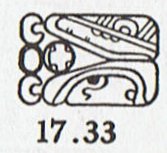
The text on the stela shows that
this glyph indicates the passage of one day, from
6 Eb, 0 Pop to 7 Eb, 1 Pop; the sun or
kin, preceded by the numeral 1, is seen entering
between the caban-sign and what we shall
later come to identify as the sky-glyph ...
In the
beginning there were only Sky and Earth 'in close
embrace', and when Air entered in between them it
was a fundamental change from 2 to 3.
... The ancient Chinese said:
One generates Two, Two generates Three, and Three
generates Everything.
And
reasonably there should be a Sign of '3' where this
event occurred. At left in glyph 17.33 a triplet of
'stones' arranged vertically could have visualized
the season of Sky (top), the season of Air
(central) and the season of Earth (bottom). But
since top and bottom are quite similar the meaning
could be the northern sky respectively the southern
sky with the equatorial (inhabitable) belt in
between ... |
|
CLOSE TO
THE SUN: |
|
Nov 13
κ
Librae (237.2),
ι
Serpentis (237.4),
ψ²
Lupi,
ρ
Oct.
(237.5), γ Cor. Borealis, η Librae (237.7),
COR
SERPENTIS = α Serpentis
(237.9)
*196.0 = *237.4 - *41.4 |
14
π
Cor. Borealis,
UNUK
ELHAIA (Necks of the Serpents) = λ Serpentis
(238.1),
CHOW =
β Serpentis
(238.6) |
15
κ
Serpentis (239.3),
δ
Cor. Borealis,
TIĀNRŪ
= μ Serpentis
(239.5),
χ
Lupi, (239.6),
ω
Serpentis (239.7),
BA (=
Pa) = ε Serpentis,
χ
Herculis (239.8).
κ
Cor.
Borealis, ρ Serpentis (239.9) |
16 (320)
λ
Librae (240.0),
β
Tr. Austr. (240.3),
κ
Tr. Austr. (240.4),
ρ
Scorpii (240.8)
*199.0 = *240.4 - *41.4 |
|
'Oct 17
(290) |
18 |
19 (292
= 4 * 73) |
20 |
|
"Oct 3 |
4 (277) |
5 |
6 |
|
SEPT 10 |
11 |
12 (255
= 3 * 85) |
13 |
|
DAY 237 |
238 |
239 |
240 |
|
CLOSE TO THE FULL
MOON: |
|
May 14
δ Persei (54.7) |
500 =
365 + 135
Al Thurayya-27 (Many Little Ones) /
Krittikā-3 (Nurses of Kārttikeya) /
TAU-ONO (Six Stones)
ATIKS
= ο Persei,
RANA
(Frog) = δ Eridani
(55.1),
CELAENO (16 Tauri), ELECTRA (17), TAYGETA (19),
ν
Persei (55.3),
MAIA
(20), ASTEROPE (21), MEROPE (23)
(55.6) |
16 (136)
Hairy Head-18 (Cockerel) /
Temennu-3 (Foundation Stone)
ALCYONE
(56.1),
PLEIONE
(28 Tauri),
ATLAS (27 Tauri)
(56.3) |
17
MENKHIB (Next to the Pleiades = ζ Persei
(57.6)
PORRIMA (γ Virginis) |
|
'April
17 (80 + 27) |
18 (108 = 135 - 27) |
19 |
20 |
|
BISSEXTUM (54 - 55) |
56 (8
WEEKS) |
57 (=
137 - 64 - 16) |
|
... The leap day was introduced as part of the
Julian reform. The day following the Terminalia
(February 23) was doubled, forming the 'bis
sextum - literally 'double sixth', since
February 24 was 'the sixth day before the Kalends of
March' using Roman inclusive counting (March 1 was
the 'first day'). Although exceptions exist, the
first day of the bis sextum (February 24) was
usually regarded as the intercalated or 'bissextile'
day since the third century. February 29 came to be
regarded as the leap day when the Roman system of
numbering days was replaced by sequential numbering
in the late Middle Ages ... |
|
"April 3
|
4 |
5 |
6 (96) |
|
MARCH 11 |
12 (135
- 64 = 71) |
13 |
14 (→ π) |
|
DAY 54 |
55 |
56 |
57 |
|
54 Vai Rapa |
- |
56 (Sic!) Vai
Rutu Manu |
57 Hanga Piko |
|
54 vai rapa
a hakaremereme |
56 te vai rutu manu a koro rupa.e
haho e hivi e
e runga e
te puku ohu kahi e. |
57 hanga
piko a hare rutu manu a
ana onoono
a Pu
ngotangota. |
|
According to Barthel the 'shimmering
water' (vai rapa) was located north of Ana
Kai Tangata (Cave for Eating Man) with Hanga
Piko (Curved Bay) a bit further north. In
between was Te Vai Rutu Manu:
... The
'watering place' where the bird beats (the rhythm)'
- wordplay, 'where a certain chant is being recited'
- is located near Hanga Piko. A recitation provides
the following information for the additional name:
'In Koro Rupa is the house where one is made to
laugh; in Kere Mea is the house where one is made
fun of' (Barthel 1960:851; Campbell 1971:400). There
the rule of the new birdman was celebrated (compare
koro 'feast'). In RAP., koro rupa
seems to have the same meaning as in TUA.
kororupo, which describes a paradise. In the
cosmology of the TUA., the name also referred to the
entrance to the underworld. Hivi (maybe the
same as hi ivi 'to fish with a hook made from
bone'; compare the narrative ME:363) is 'outside',
and 'the elevation from where (the catch of) the
tunafish is announced' is 'above'. This is a
reference to a large boulder beside the place where
the canoes docked in Hanga Piko. There the people
waited for the canoes to return from the fishing
grounds." (The Eighth Land, pp. 89-90.)
Kahi.
Tuna; two sorts: kahi aveave, kahi matamata.
Vanaga. Mgv.: kahi, to run, to flow. Mq.:
kahi, id. Churchill. Rangitokona, prop up
the heaven! // Rangitokona, prop up the
morning! // The pillar stands in the empty space.
The thought [memea] stands in the earth-world
- // Thought stands also in the sky. The kahi
stands in the earth-world - // Kahi stands
also in the sky. The pillar stands, the pillar - //
It ever stands, the pillar of the sky. (Morriori
creation myth according to Legends of the South
Seas.)
Puku. 1. To
feel an urge to defecate or to urinate, etc.:
ku-puku-á te mimi: to need to urinate. 2. Rock,
boulder: puku ma'ea; puku oone,
hillock, earth mound. 3. Puku tagata, pubis.
Puku-ine, to get stuck in the oesophagus (of
food). Pukupuku, joints, bones of a joint;
pukupuku rima, wrist bones; pukupuku va'e,
ankle. Pukuraga, followers, disciples,
students. Puku rekoreko is the juicy part
between two knots (puku). Vanaga. 1. Puku
haga oao, east, east wind. 2. Pubes. T Mgv.:
puku, clitoris; pukuhou, the age of
puberty; pukutea, a man between 30 and 45. 3.
Unripe; puku no, unripe; pukupuku,
green, immature. Mgv. puku, to be unripe.
Mq.: puku, a fruit which has not yet reached
its maturity. 4. To gorge; mahaga puku, to
take the bait greedily. PS Sa.: pu'u, to take
the whole at one mouthful, to put into the mouth
whole. Fu.: pukupuku, to rinse the mouth, to
gargle. Niuē:
puku, to take
into the mouth. Pukuhina,
(puku 4),
to choke on a fishbone. Pau.: pukua,
to choke with a fishbone. Mgv.: pukua,
to be suffocated by anything that sticks in the
throat. Mq.: pukua,
bad deglutition. Ta.: puunena,
puufeto,
to choke, to gag. Ha.: puua,
to be choked, to have something sticking in the
throat. Pukupuku;
1. Elbow. G. 2. Wrinkled, knotty, wen, scrofula;
gao pukupuku,
scrofula. T Pau.: puku,
a swelling; pukupuku,
a wrinkle, knotty, rough. Mgv.: puku,
a knot in the wood; pukupuku,
knotted, rough, uneven, lumpy. Mq.: puku,
knot in wood, boss, protuberance, tumor, boil;
toopuku, toopuu, boil, wart,
tumor;
pukupuku, wrinkled,
knotty. Ta.: puú,
boss, protuberance, swelling; puúnono,
tumour; puúpuú,
wrinkled, knotty. Pukuraga,
servant T. Churchill. Rei matapuku,
necklace made of coral or of mother-of-pearl. Henry.
Ohua. Night in
the Moon calendar:
 |
 |
 |
|
Ohua |
Otua |
|
CLOSE TO THE SUN: |
|
12h (182.6) |
ALCHITA |
PÁLIDA |
|
DAY 182 |
183 |
184 |
|
CLOSE TO THE FULL MOON: |
|
March 20 |
SIRRAH |
ALGENIB PEGASI |
|
DAY 364 |
0h (365.25) |
1 |
This 'bird beating the rhythm' was
mentioned also at the item for Hanga Piko, in
the house (hare) of the cave (ana)
'SixSix' (onoono).
"Ana
Onoono is a cave well-suited as an overnight
shelter; Pu Ngotangota is a coastal formation where
the seawater is allowed to flow in and out. The
three additions, 'house', 'cave', and 'hole', always
describe an enclosed area." (Barthel, a.a., p 90)
Clearly Ana Onoono may have
been referred to earlier in Manuscript E, when they
carried the severely injured Kuukuu down into
a cave and piled up 6 stone heaps outside who would
answer when he called out → 6 heaps for 6 men →
36(0).
Likewise can we perceive a
correspondence between the coastal formation Pu
Ngotango, where water freely flowed in and out,
and the movements of the explorers when they
'behaved like turtles', when they rode the waves
repeatedly towards the beach. 'Turtle' → boat (cfr
Zaurak).
...
po-tagotago, darkness. po o te tagata,
life ... |
|
... we read of a fisherman later revered as a deity
named Urashima: He was hadsome of feature ...
He went out alone in a boat to fish with hook and
line. During three days and nights he caught
nothing, but at length he caught a turtle of five
colours. Wondering, he put it in the boat ... While
he slept the turtle suddenly became transformed into
a woman, in form beautiful beyond description ... He
said to her, 'This place is far from the homes of
people, of whom there are few on the sea. How did
you so suddenly come here?' Smiling she replied, 'I
deemed you a man of parts alone on the sea, lacking
anyone with whom to converse, so I came here by wind
and cloud.'
She is, of course, a Kami [a spirit], as he
quickly understands, from a magical land that 'lasts
as long as sky and earth and ends with sun and
moon'. And she tempts him: 'You can come to that
region by a turn of your oar. Obey me and shut your
eyes.' So presently they came to a broad island in
the wide sea, which was covered with jewels. (On it
was a great mansion.) Its high gate and towers shone
with a brilliance which his eyes had never beheld
and his ears had never heard tell. They enter the
mansion and are received and greeted in a loving
fashion by her parents: 'Seated they conversed of
the difference between mankind and the
Land-of-Spirits, and the joy of man and Kami
meeting.
Eventually the fisherman Urashima and the
beautiful sea Kami are married. Thereafter:
'For three years, far from his aged parents, he
lived his life in the Spirit capital, when he began
to yearn for his home and for them.' Observing the
change in him, his wife asks: 'Do you desire to
return home?' He replies: 'To come to this far
Spirit Land, I parted from my near and kin. My
yearning I cannot help ... I wish to return to my
native place to see my parents for a while'. Then we
read: Hand in hand they walked conversing ... till
they came to where their ways diverged and where her
parents and relatives, sorrowing to part with him,
made their farewells.
The princess informed him that she was indeed the
turtle which he had taken in his boat, and she took
a jewel-casket and gave it to him saying: 'If you do
not forget me and desire to seek me, keep this
casket carefully, but do not open it.' Thus he
parted from her and entered his boat, shutting his
eyes as she bade him. In a trice Urashima
finds himself back in his home village again but a
terrible surprise awaits him. During the three years
that he has spent enchanted on the Spirit island 300
mortal years have passed and everything has changed
beyond recognition. Stumbling around dazed and
disconsolate, discovering from a passer-by that his
own disappearance three centuries previously is
itself now the subject of a village legend, he
forgets the warning about the jewel box and opens it
to remind himself of his Kami wife: 'But
before he could look into it, something in the form
of a blue-orchid soared up to the blue sky with the
wind and clouds. Then he knew that, having broken
his oath, he could not go back and see her again
... |
|
... Several Asian
cultures, including that of the Andaman Islands,
believe that humanity emerged from a bamboo stem. In
the Philippine creation myth, legend tells that the
first man and the first woman were split open from a
bamboo stem that emerged on an island created after
the battle of the elemental forces (Sky and Ocean).
In Malaysian
legends a similar story includes a man who dreams of
a beautiful woman while sleeping under a bamboo
plant; he wakes up and breaks the bamboo stem,
discovering the woman inside. The Japanese folktale
'Tale of the Bamboo Cutter' (Taketori Monogatari)
tells of a princess from the Moon emerging from a
shining bamboo section. Hawaiian bamboo ('ohe)
is a kinolau or body form of the Polynesian
creator god Kane.
An ancient
Vietnamese legend tells of a poor, young farmer who
fell in love with his landlord's beautiful daughter.
The farmer asked the landlord for his daughter's
hand in marriage, but the proud landlord would not
allow her to be bound in marriage to a poor farmer.
The landlord decided to foil the marriage with an
impossible deal; the farmer must bring him a 'bamboo
tree of one-hundred sections'. The benevolent god
Bụt appeared to the farmer and told him that
such a tree could be made from one-hundred sections
from several different trees. Bụt gave the
him four magic words to attach the many sections of
bamboo: 'Khắc nhập, khắc xuất', which means
'put in immediately, take out immediately'. The
triumphant farmer returned to the landlord and
demanded his daughter. The story ends with the happy
marriage of the farmer and the landlord's daughter
... |
There was no 'marker post' placed out by Makoi between
number 54 and 56, there was only a 'hole'. We can compare with number 400:
... The Sacred Book of the ancient Maya
Quiche, the famous Popol Vuh (the Book of Counsel) tells
of Zipacna, son of Vucub-Caquix (= Seven Arata). He sees 400
youths dragging a huge log that they want as a ridgepole for
their house. Zipacna alone carries the tree without effort to
the spot where a hole has been dug for the post to support the
ridgepole. The youths, jealous and afraid, try to kill Zipacna
by crushing him in the hole, but he escapes and brings down the
house on their heads. They are removed to the sky, in a 'group',
and the Pleiades are called after them ...
If 500 corresponded to 400, then this Quiche year ought to have
begun at April 10 (100), because May 15 would then be day 135 -
100 = 35 = 400 - 365.
And when king Matua brought out his '600 men' (eono te rau)
it could therefore have alluded to the name Tau-ono (6
stones) for the first day of the Pleiades. And his year could
consequently have begun 100 days earlier than January 1.
366 (January 1) - 100 = 266 (September 23) = the day after the
equinox:
|
no glyph |
koia |
ki te
hoea |
ki te henua |
te rima te hau tea |
haga i te mea ke |
ki te henua -
tagata honui |
|
Ko. 1. Article (ko te);
preposition: with (see grammar); prefix of
personal pronouns: koau, I; kokoe, you
(singular); koîa, he, she, it; kokorua,
you (plural); ko tagi, koîa, he with his
weeping. 2. Article which precedes proper nouns,
often also used with place names: Ko Tori, Ko
Hotu Matu'a, Ko Pú.
Koîa, exact: tita'a koîa, exact
demarcation. Seems to be the personal pronoun
koîa - applied in the meaning of: thus it is,
here it is precisely. Vanaga. 1. Negative;
e ko, not, except; e ko ora, incurable;
ina ko, not; ina ko tikea, unseen;
ina e ko, not; ina e ko mou, incessant.
2. A particle used before nouns and pronouns; ko
vau, I; ko te, this; ko mea tera,
this; ati ko peka, to avenge, ko mua,
first, at first, formerly. 3. There, yonder. P Mgv.:
ko, over there, yonder. Ta.: ó, there,
here. Churchill.
Hoe. Hoe 1. Paddle. Mgv.:
hoe, ohe, id. Mq., Ta.: hoe, id.
2. To wheeze with fatigue (oeoe 2). Arero
oeoe, to stammer, to stutter; Mgv. oe, to
make a whistling sound in breathing; ohe, a
cry from a person out of breath. Mq.: oe, to
wheeze with fatigue. 3. Blade, knife; hoe
hakaiu, clasp-knife, jack-knife; hoe hakanemu,
clasp-knife; hoe pikopiko, pruning knife. 4.
Ta.: oheohe, a plant. Ma.: kohekohe,
id. Churchill.T. Paddle. E hoe te heiva =
'and to paddle (was their) pleasure'. Henry. Hoea,
instrument for tattooing. Barthel.
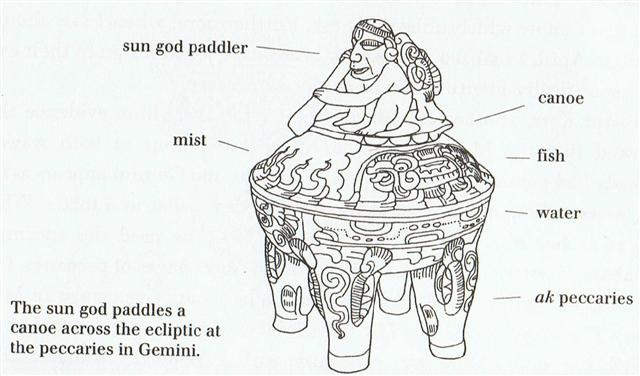 |
 |
 |
 |
 |
 |
 |
|
Ca1-1 |
Ca1-2 |
Ca1-3 |
Ca1-4 |
Ca1-5 |
Ca1-6 |
|
CLOSE TO
THE SUN: |
|
Sept 20
(263) |
21 |
Equinox |
23 |
24 |
25 (84 + 184) |
26 |
|
ALCHITA
= α Corvi,
MA
WEI (Tail of the Horse) = δ Centauri
(183.1),
MINKAR = ε Corvi
(183.7), ρ Centauri (183.9) |
PÁLIDA (Pale) = δ Crucis
(184.6),
MEGREZ (Root of the Tail) = δ Ursae Majoris
(184.9) |
Hasta-13 (Hand) /
Chariot-28 (Worm)
GIENAH (Wing) = γ Corvi
(185.1),
ε
Muscae (185.2),
ζ
Crucis (185.4),
ZANIAH (Corner) = η Virginis
(185.9)
*144.0 = *185.4 - *41.4 |
CHANG SHA (Long
Sand-bank) = ζ Corvi
(186.3) |
INTROMETIDA (Inserted) =
ε
Crucis
(187.4),
ACRUX =
α
Crucis
(187.5)
*146.0 =
*187.4 - *41.4 |
γ
Com. Berenicis (188.0),
σ
Centauri (188.1),
ALGORAB = δ Corvi
(188.5),
GACRUX = γ Crucis
(188.7) |
γ
Muscae (189.0),
AVIS SATYRA (Bird of the Satyrs) = η Corvi
(189.3),
ASTERION (Starry) = β Canum Ven.
(189.5),
KRAZ = β Corvi,
κ Draconis (189.7) |

... Raven gazed up and down the beach. It was
pretty, but lifeless. There was no one about to
upset, or play tricks upon. Raven sighed. He crossed
his wings behind him and strutted up and down the
sand, his shiny head cocked, his sharp eyes and ears
alert for any unusual sight or sound. The mountains
and the sea, the sky now ablaze with the sun by day
and the moon and stars he had placed there, it was
all pretty, but lifeless. Finally Raven cried out to
the empty sky with a loud exasperated cry. And
before the echoes of his cry faded from the shore,
he heard a muffled squeak. He looked up and down the
beach for its source and saw nothing. He strutted
back and and forth, once, twice, three times and
still saw nothing. Then he spied a flash of white in
the sand. There, half buried in the sand was a giant
clamshell. As his shadow fell upon it, he heard
another muffled squeak. Peering down into the
opening between the halves of the shell, he saw it
was full of tiny creatures, cowering in fear at his
shadow ... |
|
CLOSE TO THE FULL
MOON: |
|
March 21
(80)
Al Fargh al Thāni-25 (Rear Spout)
0h (365.25)
CAPH
(Hand) = β Cassiopeiae,
SIRRAH (Navel of the Horse)
=
α
Andromedae
(0.5),
ε
Phoenicis,
γ³
Oct.
(0.8) |
22
Uttara Bhādrapadā-27 (2nd of the Blessed Feet) /
Wall-14 (Porcupine)
ο Oct. (1.3),
ALGENIB PEGASI = γ Pegasi
(1.8) |
23
χ Pegasi (2.1), θ Andromedae (2.7) |
24
σ
Andromedae (3.0), ι Ceti (3.3), ζ Tucanae (3.5), ρ
Andromedae, π Tucanae (3.7) |
Julian equinox
no
star listed (4) |
26 (85 =
185 - 100)
ANKAA = α Phoenicis,
κ Phoenicis (5.0)
ALPHARD (α
Hydrae)
|
27
λ
Phoenicis (6.3), β Tucanae (6.4)
*148.0
+ *183.0 = *331.0 = *6.4 - *41.4 + *366.0 |
|
'Febr 22
(53) |
23
(Terminalia) |
BISSEXTUM (54 - 55) |
26 |
27 |
28 |
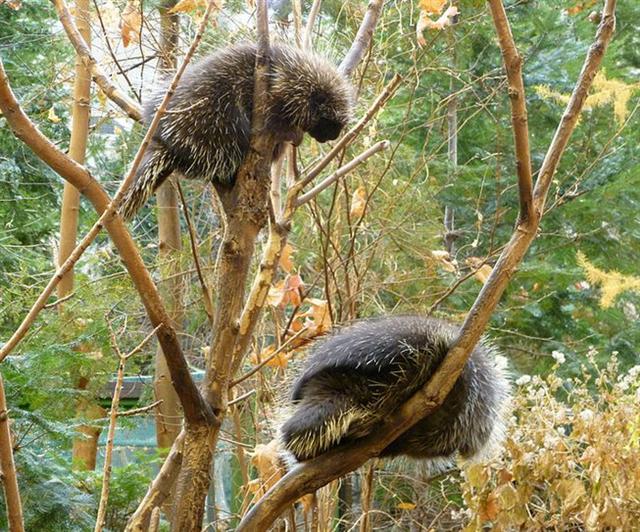
... The players
all played at once, without waiting for turns,
quarreling all the while, and fighting for the
hedge-hogs; and in a very short time the Queen was
in a furious passion, and went stamping about, and
shouting 'Off with his head!' or 'Off with her
head!' about once in a minute. Alice began to feel
very uneasy: to be sure, she had not as yet had any
dispute with the Queen, but she knew that it might
happen any minute, 'and then', thought she, 'what
would become of me?' They're dreadfully fond of
beheading
people here: the great
wonder is, that there's any one left alive! ... |
Another way of perceiving it is to add 100 to day 500.
This will bring us to glyph number 421 + 100 = 521 in the C
text:
| ihe tamaiti |
kotia - te hokohuki |
kava haati |
kiore |
te hokohuki |
kua tu te rau hei |
te moko - te hokohuki |
|
Tia.
(Tiha G) .To sew. T Mgv.: tia, to
prick, to pierce, to stick in. Churchill. Ta.: tia,
the lower belly. Mq.: tia-kopu, pubes. Ma.:
tia, the lower abdomen. Tiahonu, to piece
together. Mq.: tuhonu, to mend, to patch. Ma.:
tuhonu, to join. Churchill. Mq.: tiaha,
drinking cup. Ha.: kiaha, a cup, a mug. Tikao,
to dig out, to disembowel. Ma.: tikaro, to dig
out of a hole. Churchill. KIA. s. Haw.,
pillar or inner post of a house supporting the roof, any
kind of pillar or post, a mast of a vessel; kia-aina, a
supporter of the land, a governor of a province. Marqu.,
tia, id. Sam., ti'a, the stick used in
tanga-tia, a man's head (abusively); tia-pula,
taro-tops cut off for planting. Sunda, tihang.
Mal., tiang, a pillar. Greek, κιων,
a pillar, support of the roof, the identical sense of
the Polynesian usage of the word. Liddell and Scott give
no etymology or connections of κιων.
(Fornander) |
 |
 |
 |
 |
 |
 |
 |
|
Cb6-5 (146 +
366) |
Cb6-6 (11 *
11) |
Cb6-7 (392 +
122) |
Cb6-8 (515) |
Cb6-9 |
Cb6-10 |
Cb6-11 |
|
CLOSE TO THE FULL
MOON: |
|
Rishu A.-13 (Head of the Lion)
ψ Leonis (146.4),
RAS ELASET AUSTRALIS = ε Leonis
(146.6)
*105.0 = *146.4 - *41.4 |
VATHORZ PRIOR = υ Carinae
(147.9) |
υ¹
Hydrae (148.4),
RAS ELASET BOREALIS (Northern Head of the Lion) =
μ
Leonis
(148.7)
*107.0 = *148.4 - *41.4 |
TSEEN KE (Heaven's Record) = φ Velorum
(149.9) |
ν Leonis (150.1), π Leonis (150.6) |
υ² Hydrae (151.8) |
Al Jabhah-8 (Forehead) /
Maghā-10 (Bountiful) /
Sharru-14 (King)
10h (152.2)
AL JABHAH = η Leonis
(152.4),
REGULUS
(Little KIng) =
α
Leonis
(152.7)
*111.0 = *152.4 - *41.4 |
 |
|
Aug 14 |
15 (227) |
16 |
17 |
18 |
19 |
20 |
|
'July 18 |
19 (200) |
20 |
21 |
22 |
23 |
24 |
|
"July 4 |
5 |
6 |
7 (188) |
8 |
9 |
TE ANAKENA
10 |
|
... They took their provisions with
them, carrying them on their shoulders, went on, and
reached Te Pou. They made camp and slept in Te
Pou on the tenth day of the month of July ('Anakena')
... (E:22) |
|
HELIACAL STARS: |
|
Arkat sha hi-na Shahū-27 (Eastern One in the Tail of the
Goat)
ENIF (The Nose) = ε Pegasi, ERAKIS = μ Cephei
(329.2),
46 CAPRICORNI,
JIH (the Sun) =
κ
Pegasi
(329.3),
ι
Piscis Austrini (329.4),
λ
Capricorni (329.6),
ν
Cephei (329.7),
DENEB ALGIEDI
=
δ
Capricorni
(329.8)
*288.0 = *329.4 - *41.4 |
θ
Piscis Austrini (330.1),
λ
Oct.
(330.7) |
KUH (Weeping) =
μ
Capricorni
(331.4),
γ
Gruis (331.5)
*290.0 = *331.4 - *41.4 |
no star listed (332) |
η Piscis Austrini (333.4)
*292.0 = *333.4 - *41.4 |
22h (334.8)
KAE UH (Roof) = ο Aquarii
(334.0),
AL KURHAH (White Spot) = ξ Cephei
(334.4),
SADALMELIK
(Lucky King) = α Aquarii,
AL DHANAB (The Tail) = λ Gruis
(334.6), ι Aquarii, ν Pegasi (334.7)
*293.0 = *334.4 - *41.4 |
ι Pegasi (335.0),
ALNAIR (The Bright One) = α Gruis
(335.1), μ Piscis Austrini, υ Piscis Austrini (335.3),
WOO (Pestle) = π Pegasi
(335.7),
BAHAM = θ Pegasi,
τ Piscis Austrini (335.8) |
|
July 4 is the 185th
day of the year (186th in leap years) in the Gregorian
calendar. There are 180 days remaining until the end of
the year. The Aphelion, the point in the year when the
Earth is farthest from the Sun, occurs around this date
...
1776 (= 4 * 444) AD
was a leap year and therefore July 4 was not day 185 but
day 186.
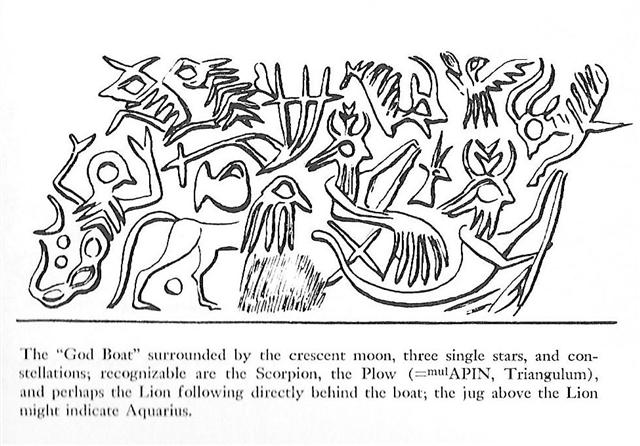
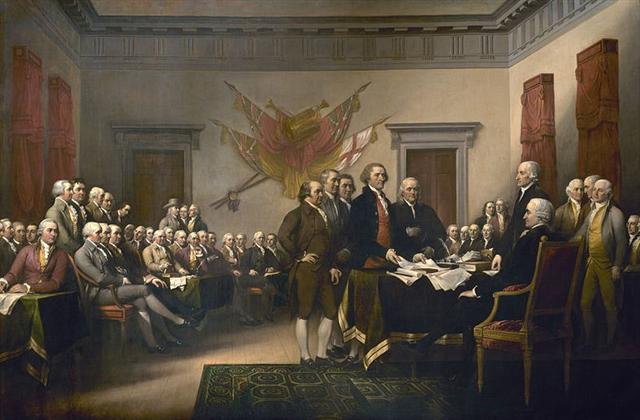
... Ira grew angry and quarreled [he
kakai] with Makoi. He said the following (to him):
'You did not pay attention, last-born, and you did not [tae]
give the (full) name. This is how it should be [Penei]:
the Manavai of Hau Maka of Hiva, in memory (mo aringa
ora) of the father, of his dream soul'. Makoi
replied, 'In Hiva the land belongs to him - the land
here is mine, not his [tae oona]!' (E:21) |
| tu te rau hei |
ku
hakahonui raua |
kiore |
hokohuki |
te rau hei |
te moko e te hokohuki |
 |
 |
 |
 |
 |
 |
 |
|
Cb6-12 |
Cb6-13 → 183 |
Cb6-14 (521) |
Cb6-15 |
Cb6-16 |
Cb6-17 |
Cb6-18 |
|
CLOSE TO THE FULL
MOON: |
|
Aug 21 |
22 (193 +
41) |
23 (*155) |
24 (8 * 29½) |
25 (237) |
26 |
27 |
|
'July 25 |
26 (*127) |
27 |
28 |
29 (210 =
237 - 27) |
30 |
31 |
|
"July 11 (192) |
12 |
13 |
*115 →
HIRO |
15 |
16 |
17 |
|
λ Hydrae
(153.2) |
ADHAFERA = ζ Leonis,
TANIA BOREALIS (Northern Gazelle) = λ Ursae Majoris,
SIMIRAM = ω Carinae
(154.7) |
ALGIEBA
(The Mane) =
γ
Leonis,
q Carinae (155.5) |
TANIA AUSTRALIS (Southern Gazelle) =
μ
Ursae Majoris
(156.0),
GHOST OF JUPITER = NGC3242 Hydrae
(156.8) |
Extended Net-26b (Ox)
μ Hydrae
(157.1) |
Maru-sha-arkat-Sharru-15 (4th Son behind the King)
SHIR (Possessing Luminous Rays) =
ρ
Leonis
(158.9) |
p Carinae
(159.3) |
|
... From a point a
little to the west of ζ
[Adhafera, ζ Leonis] and not
much farther from γ - when
first observed the radiant point was in Cancer - issue
the Leonids, the meteor stream of November 9th to
17th, its maximum now occurring on the 13th to 14th,
which about every thirty-three years has furnished such
wonderful displays, the last in 1866 and the next due in
1899.
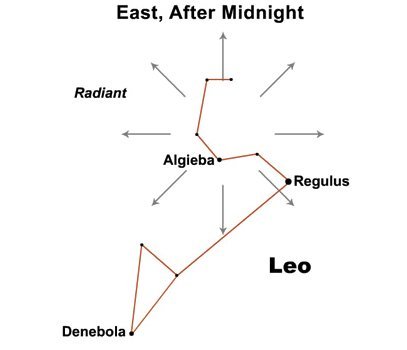
Their first noticed
appearance may have been in the year 137, since which
date the stream has completed fifty-two revolutions.
According to Theophanes of Byzantium, the shower was
seen from there in November, 472; but the late Professor
Newton, our deservedly great authority on the whole
subject of meteors, commenced his list of the Leonids
with their appearance on the 13th of October, 902, the
Arabian Year of the Stars, during the night of the death
of King Ibrahim ben Ahmad, and added: It will be seen
that all these showers are at intervals of a third of a
century, that they are at a fixed day of the year, and
that the day has moved steadily and uniformly along the
calendar, at the rate of about a month in a thousand
years ...
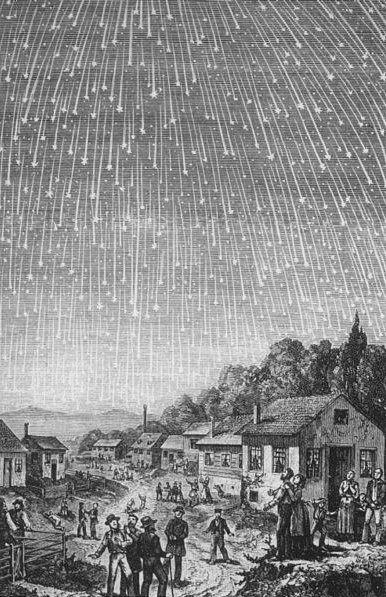

HANGA
TAKAURE
 |
| kua
tupu te mea ke |
kotîa hia |
te kava tu |
|
Tia.
(Tiha G) .To sew. T Mgv.: tia, to
prick, to pierce, to stick in. Churchill. Ta.:
tia, the lower belly. Mq.: tia-kopu,
pubes. Ma.: tia, the lower abdomen.
Tiahonu, to piece together. Mq.: tuhonu,
to mend, to patch. Ma.: tuhonu, to join.
Churchill. Mq.: tiaha, drinking cup. Ha.:
kiaha, a cup, a mug. Tikao, to dig out,
to disembowel. Ma.: tikaro, to dig out of a
hole. Churchill. KIA. s. Haw., pillar
or inner post of a house supporting the roof, any
kind of pillar or post, a mast of a vessel;
kia-aina, a supporter of the land, a governor of a
province. Marqu., tia, id. Sam., ti'a,
the stick used in tanga-tia, a man's head
(abusively); tia-pula, taro-tops cut off for
planting. Sunda, tihang. Mal., tiang,
a pillar. Greek,
κιων,
a pillar, support of the roof, the identical sense
of the Polynesian usage of the word. Liddell and
Scott give no etymology or connections of
κιων.
(Fornander) |
 |
 |
 |
 |
 |
|
Cb6-19 |
Cb6-20 |
Cb6-21 (136) |
(392 +
137 = 529) |
Cb6-23 →
6 * 23 = 186 |
|
CLOSE TO THE FULL
MOON: |
|
Aug 28 |
29 |
30 (242) |
31 |
Sept 1 |
|
'Aug 1 |
2 |
3 |
4 |
5 |
|
"July 18 |
19 (200) |
20 |
21 |
22 / 7 →
π |
|
φ Hydrae
(160.3) |
no star
listed (161) |
VATHORZ
POSTERIOR = θ Carinae
(162.1),
PEREGRINI = μ Velorum,
η Carinae
(162.6) |
ν Hydrae
(163.1) |
no star
listed (164)
ALTAIR (α
Aquilae)
|

...
This [η
Carinae] is one of the most noted objects in the
heavens, perhaps even so in almost prehistoric
times, for Babylonian inscriptions seem to refer to
a star noticeable from occasional faintness in its
light, that Jensen thinks was
η.
And he claims it as one of the temple stars
associated with Ea, or
Ia, of
Eridhu, the Lord of Waters, otherwise known as
Oannes,
the mysterious human fish
and greatest god of the kingdom. |
|
HANGA
HOONU |
An Ox is an emasculated Bull and there was a Net
Extended for 27 right ascension days.
... it is told that he [Gilgamesh] lives
in splendor and dissoluteness, and makes a nuisance of
himself until the gods bring relief to his people by rearing
a human being, either twin or counterpart,³ who can stand up
to him. It is Enkidu, the man of the Wilds, a kind of
wolf-child as simple as the beasts
he plays with, a happy son of nature, hairy all over, grown
to enormous strength ...
³ Actually, the goddess Aruru makes him
'in the likeness of Anu', literally 'a zikru of Anu
she conceived in her heart'. But Enkidu is also said to look
like Gilgamesh 'to a hair' ...
... Ishtar appears on the walls of Uruk
and curses the two heroes who have shamed her, but Enkidu
tears out the right thigh of the Bull of Heaven and flings
it in her face, amidst brutal taunts. It seems to be part of
established procedure in those circles. Susanowo did the
same to the sun-goddess Amaterasu, and so did Odin the Wild
Hunter to the man who stymied him. A scene of popular
triumph and rejoicings follows. But the gods have decided
that Enkidu must die, and he is warned by a somber dream
after he falls sick ...
There were 27 right ascension days from Sirrah (*0) to The
Front of the Head of Ku (*27).
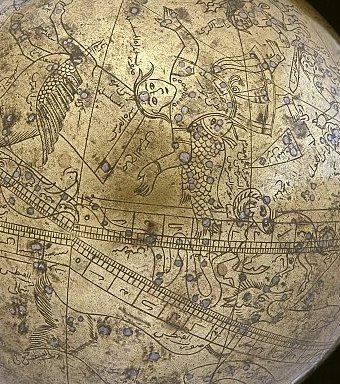
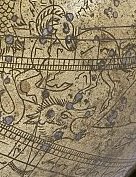
|






























